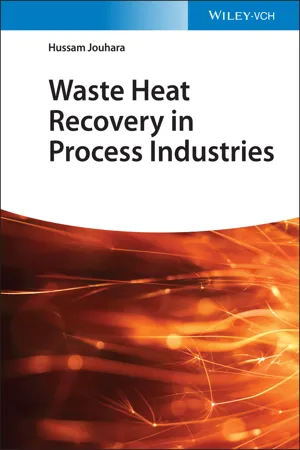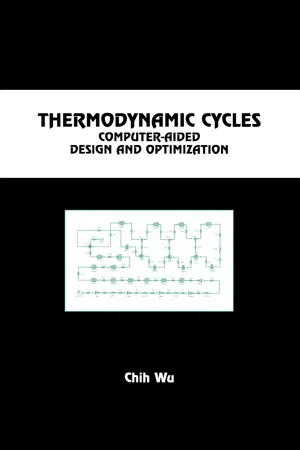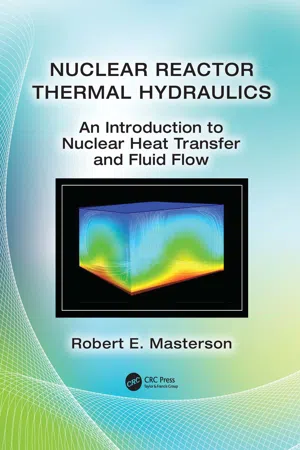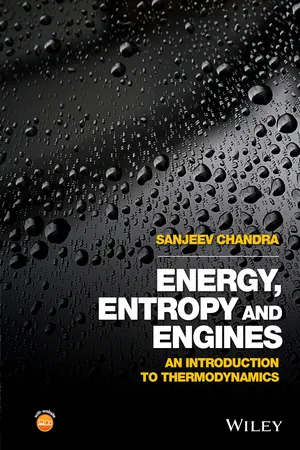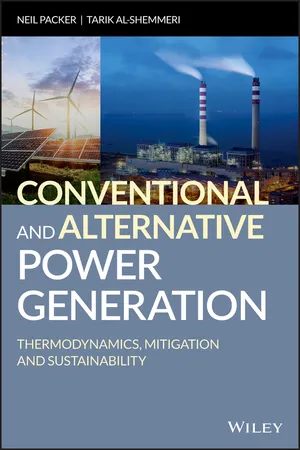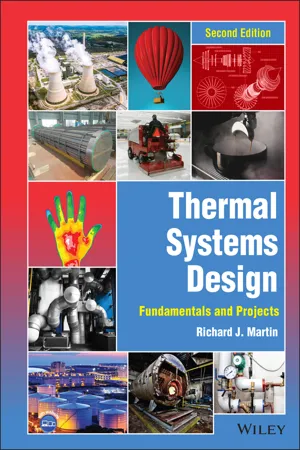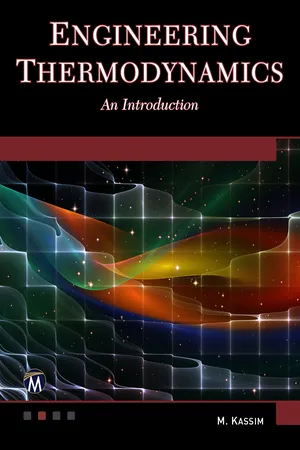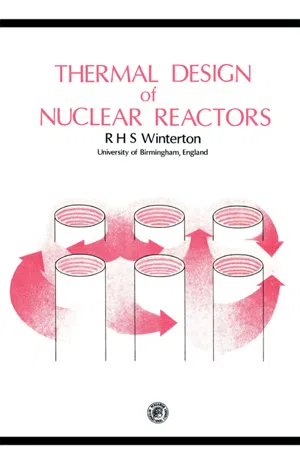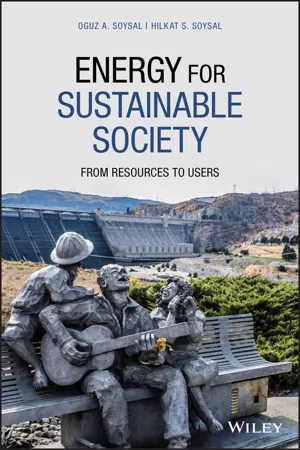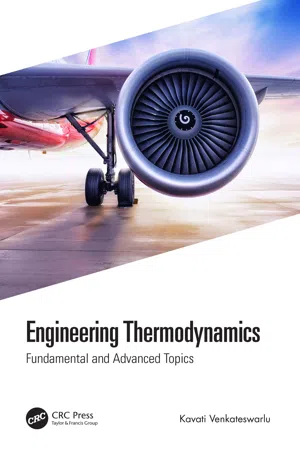Technology & Engineering
Reheat Rankine Cycle
The Reheat Rankine Cycle is a thermodynamic cycle used in power plants to improve the efficiency of steam turbines. It involves reheating the steam at an intermediate pressure before it enters the low-pressure turbine, which allows for more work to be extracted from the steam. This process helps to increase the overall efficiency of the power plant.
Written by Perlego with AI-assistance
Related key terms
12 Key excerpts on "Reheat Rankine Cycle"
- eBook - ePub
- Hussam Jouhara(Author)
- 2021(Publication Date)
- Wiley-VCH(Publisher)
Figure 1.20 ), and this steam is then reheated and expanded in the second turbine from MP to LP. The main advantage of the reheat is to increase the steam quality to ensure a steadier thermodynamic efficiency.Rankine cycles with reheat also ensure a higher overall mechanical efficiency by using two turbines for the cycle compared to only using one. In this configuration, the overall efficiency of the cycle is given by:(1.24)where, qinBcorresponds to the heat (kJ/kg) provided by the boiler to the fluid and qinRcorresponds to the heat (kJ/kg) provided by the reheater to the fluid (In real-life power plant, the boiler and the superheater use the same heat source.)Schematic of the Rankine cycle with reheat.Figure 1.19T–s diagram of a Rankine cycle with reheat.Figure 1.201.2.4.5 Regenerative Rankine Cycles
To improve energetic and exergetic efficiency of the thermodynamic cycle, the regenerative Rankine cycles extracts a portion of the steam from the turbine to heat the fluid before it is sent to the boiler. This results in a small reduction in the work provided to the turbine but a substantial reduction in the heat input, because the heating phase creates entropy and thus irreversibility if this is all provided by the boiler. The portion of steam used therefore helps the boiler heat the fluid, reducing the fuel required by the boiler and hence both energetic and exergetic efficiencies improve. Furthermore, the average temperature of the heat input by the boiler is increased and this also results in a higher energetic efficiency [8] .Regenerative cycles require a new component. A feed water heater (FWH ) also called a regenerator is required, its role being to heat the feed water before it enters the boiler. There are two different kinds of regenerative cycle: the open FWH cycle and the closed FWH cycle.Open FWH cycles use an Open FWH. As seen in Figure 1.21 , this component mixes the liquid delivered from pump 1 with the extracted steam arriving from turbine. It corresponds to point 6 on the T–s diagram shown in Figure 1.22 - eBook - ePub
Thermodynamic Cycles
Computer-Aided Design and Optimization
- Chih Wu(Author)
- 2003(Publication Date)
- CRC Press(Publisher)
Fig. 2.14 .)Figure 2.14 Reheat Rankine Cycle.COMMENTS: The advantage of using reheat is to reduce the moisture content at the exit of the low-pressure turbine and increase the net power of the Rankine power plant. The one reheat Rankine basic cycle shown in Fig. 2.13 can be expanded into more than one reheat if desired. In this fashion it is possible to use higher boiler pressure without having to increase the maximum superheater temperature above the limit of the superheater tubes.Review Problems 2.5 Reheat Rankine Cycle
- What is the purpose of reheat in a Reheat Rankine Cycle?
- Is the efficiency of a Reheat Rankine Cycle always higher than the efficiency of a simple Rankine cycle operating between the same boiler pressure and condenser pressure?
- Consider a steam power plant operating on the ideal Reheat Rankine Cycle; 1 kg/sec of steam flow enters the high-pressure turbine at 15 MPa and 600°C and leaves at 5 MPa. Steam is reheated to 600°C and enters the low-pressure turbine. Exhaust steam from the turbine is condensed in the condenser at 10 kPa. Determine:
- The pump power required.
- Rate of heat added to the boiler.
- Rate of heat added in the reheater.
- Power produced by the high-pressure turbine.
- Power produced by the low-pressure turbine.
- Rate of heat removed from the condenser.
- Quality of steam at the exit of the low-pressure turbine.
- Thermal cycle efficiency.
- Consider a steam power plant operating on the ideal Reheat Rankine Cycle; 1 kg/sec of steam flow enters the high-pressure turbine at 15 MPa and 600°C and leaves at 5 MPa. Steam is reheated to 600°C and enters the low-pressure turbine. Exhaust steam from the turbine is condensed in the condenser at 10 kPa. Both turbines have 90% efficiency. Determine:
- Pump power required.
- Rate of heat added in the boiler.
- Rate of heat added in the reheater.
- Power produced by the high-pressure turbine.
- Power produced by the low-pressure turbine.
- Rate of heat removed from the condenser.
- Quality of steam at the exit of the low-pressure turbine.
- Thermal cycle efficiency.
- eBook - ePub
Thermal Power Plant
Design and Operation
- Dipak Sarkar(Author)
- 2015(Publication Date)
- Elsevier(Publisher)
Figure 1.11 ). The fundamental purpose of reheat is not to improve cycle efficiency but to reduce the moisture content of the vapor in the exhaust of the turbine. Nevertheless, with reheating the thermal efficiency of the cycle increases significantly as compared with non-reheat cycle.Figure 1.11 Reheat Rankine Cycle.In practice steam is extracted from high-pressure (HP) turbine exhaust, circulated to the boiler for re-superheating or reheating, and returned to the intermediate-pressure (IP) or low-pressure (LP) turbine for further work. Exhaust steam from the HP turbine is called “cold reheat” steam, while reheated steam coming out of the steam generator is known as “hot reheat” steam.Reheating is best suited in high-pressure units since it provides low specific volume of steam, thereby reducing the overall surface area of the reheater along with a consequent reduction in capital expenditure.From Figure 1.11 , neglecting the work input to the boiler feed pump, the work done in reheat cycle is(1.29)W o= (h 3−h 4) + (h 5−h 6)(1.29)The heat added in the steam generator(1.30)Q 1= (h 3−h 2) + (h 5−h 4)(1.30)Therefore, the efficiency of the Reheat Rankine Cycle is(1.31)η=r h(h 3−h 4) + (h 5−h 6)(h 3−h 2) + (h 5−h 4)(1.31)(Note: It should be kept in mind that by increasing the turbine inlet steam temperature and accordingly the steam pressure the cycle efficiency will always increase.)Example 1.6Using Figure 1.11 - eBook - ePub
Nuclear Reactor Thermal Hydraulics
An Introduction to Nuclear Heat Transfer and Fluid Flow
- Robert E. Masterson(Author)
- 2019(Publication Date)
- CRC Press(Publisher)
Figure 9.9 . The T–S diagram for the reheat process is shown on the right. The Rankine cycle illustrated here is different than an ideal Rankine cycle because the expansion of the steam takes place in two stages rather than just one. In the first stage (which involves the high-pressure turbine), the hot steam is expanded isentropically to an intermediate pressure, and it is then sent back to the reheaters where it is reheated at constant pressure (usually to the inlet temperature of the high-pressure turbine). It is then expanded isentropically through the low-pressure turbine before being sent on to the condenser. Thus, the total heat input and the total turbine work output when a reheat stage is added to the Rankine cycle are as follows:andHeat Input Using Reheated Steam
(9.24)Q IN=Q PRIMARY+Q REHEAT=(+)h 3−h 2()h 5−h 4Work Output Using Reheated Steam
(9.25)W TURBINE=W TURBINE1+W TURBINE2=(+)h 3−h 4()h 5−h 6Obviously, reheating the steam increases the thermal efficiency because more work can be performed by a two-stage turbine for the same energy input (h3 ). Incorporating a single reheating stage between the turbines can increase the overall efficiency by about 2% by increasing the average temperature at which heat is transferred to the steam. The average temperature during the reheating process can be increased even further by increasing the number of expansion and reheating stages and by adding more stages to the turbine drive shaft. However, a point is eventually reached (normally at about three stages) where the resulting gain in thermodynamic efficiency is too small to justify the additional cost and complexity. When this occurs, the expansion and reheating cycle approaches an isothermal process at the maximum temperature shown in Figure 9.10 .In most nuclear power plants, this point occurs when more than two reheating stages are used. The theoretical increase in the thermal efficiency from adding a second reheating stage is about half as great as the increase in the thermal efficiency from a single reheating stage alone. For this reason, very few power plants are built with more than two reheating cycles. The thermal efficiency therefore increases as - eBook - ePub
Energy, Entropy and Engines
An Introduction to Thermodynamics
- Sanjeev Chandra(Author)
- 2016(Publication Date)
- Wiley(Publisher)
Figure 9.4 ) and expands again.Rankine power cycle with reheat.Figure 9.4Reheat does not have much effect on the efficiency of the cycle, because while it increases the work output of the turbine it also requires a greater heat input. However, reheat significantly increases the quality at the exit of the low-pressure turbine. Figure 9.5 shows a Rankine cycle with reheat on a T-s diagram.The heat added in the boiler per unit mass of fluid isRankine cycle with reheat.Figure 9.5(9.11)and the total work output from the turbines per unit mass of fluid is(9.12)Example 9.3
Problem: Superheated steam at a pressure of 6 MPa and temperature of 400 °C enters the first stage of a turbine in a Rankine cycle where it expands to 0.8 MPa. The steam is then reheated to 300 °C and expanded in the second stage of the turbine which it leaves at a condenser pressure of 30 kPa. Find (a) the work done by the turbine per unit mass of fluid, (b) the heat added per unit mass of fluid and (c) the thermal efficiency of the cycle.Find: (a) Work done w per unit mass of fluid, (b) heat added q per unit mass of fluid, (c) thermal efficiency ηth of the cycle.Known: Turbine inlet pressure P2 = P3 = 6 MPa, turbine inlet temperature T3 = 400 °C, reheat pressure P4 = P5 = 0.8 MPa, reheat temperature T5 = 300 °C, condenser pressure P1 = P6 = 30 kPa.Process Diagram: The Rankine cycle with reheat on a T-s diagram (Figure E9.3 ).T-s diagram for a Rankine cycle with reheat.Figure E9.3Assumptions: Expansion through the turbines is isentropic so ∆S34 = 0 and ∆S56 = 0.Governing Equations:Work output from turbines - eBook - ePub
Conventional and Alternative Power Generation
Thermodynamics, Mitigation and Sustainability
- Neil Packer, Tarik Al-Shemmeri(Authors)
- 2018(Publication Date)
- Wiley(Publisher)
superheater.- The high‐pressure, high‐temperature superheated steam is directed onto the blades of the steam turbine. Hence, the steam energy is converted into mechanical energy driving an electric generator that is coupled on the same shaft as the turbine.
- Finally, the exhausted fluid is completely condensed and returned to the pump for recycling.
Figure 2.4 The Rankine superheat cycle.Note the difference between this and the simple Rankine cycle: superheating the steam will increase the work output in the turbine, and the quality of steam at turbine exit can be maintained as dry saturated or slightly superheated to avoid damage to the blades of the turbine caused by water droplets. However, this is accompanied by an increase in the heat supplied; the pump work is not affected.2.3.4 The Rankine Reheat Cycle
The Rankine reheat cycle (see Figure 2.5 ) is a practical cycle designed to improve the Rankine cycle; it consists of the following processes:- The working fluid, initially liquid water, is pumped (increasing its pressure) and delivered to the next unit – the boiler.
- The high‐pressure liquid water is heated in the boiler until it changes phase to water vapour. The vapour is further heated in a superheater.
- The high‐pressure, high‐temperature superheated steam is allowed to expand across a (high‐pressure, HP) turbine to an intermediate pressure above that of the condenser, i.e. an incomplete expansion. The steam is returned to the boiler and is reheated.
- The steam is returned to a separate (low‐pressure, LP) turbine and allowed to complete its expansion down to the condenser pressure. The HP and LP turbines are connected to a common shaft.
- eBook - ePub
- V. Babu(Author)
- 2019(Publication Date)
- CRC Press(Publisher)
Both the first law and the second law efficiencies are the highest seen so far. This is due to the fact that the exergy destruction during the heat addition processes is less since the temperature at entry into the boiler is higher on account of regeneration and the partial expansion in the HPT. A summary of the performance of the Rankine cycles discussed so far is given below. It may be recalled that these cycles operate between a boiler pressure of 160 bar and a condenser pressure of 0.09593 bar.Cycle Peak temp (°C) THThermal efficiency ηthSecond law efficiency ηIISpecific work (kJ/kg)W ˙x , n e tm ˙Basic 347.4 38.31 81.43 910.1 Superheat 560 42.68 72.3 1391.69 Regeneration (open) 560 45.66 76.69 1079.12 Regeneration (closed) 560 45.72 76.74 1080.42 Reheat with regeneration 560 47 78.6 1282 In actual steam power cycles, several feedwater heaters and two or more reheat stages are used in an optimal manner in order to maximize the power output as well as the thermal efficiency. With peak temperatures at values well above the critical temperature† , the efficiencies of modern steam power plants are as high as 60 percent.11.2 Air standard cycles
It may be recalled that in section 8.2 , a heat engine was defined to be a thermodynamic system that executed a cyclic process. In the case of practical realizations such as steam power generation and vapor compression refrigeration equipment, the working substance does execute a cyclic process and hence the thermodynamic analysis of the Rankine and the vapor compression cycle presented here is quite useful and provides insights into the performance of practical cycles. In contrast, in the case of engines such as gas turbine engines and automotive engines (Fig. 2.10 - eBook - ePub
Thermal Systems Design
Fundamentals and Projects
- Richard J. Martin(Author)
- 2022(Publication Date)
- Wiley(Publisher)
F to simplify the exercise. Unlike pinch, this learning simplification affects heat exchanger surface area in a marginal way only.8.3 Efficiency Improvement
The ability to capture energy that would otherwise be lost can result in significant efficiency improvements for Rankine cycle systems. Innovative methods to improve energy efficiency are nearly always installed first on large utility boilers because the payback is easier to demonstrate. Figure 8.6 shows an artist's rendering of a full‐scale, utility power plant based on the Rankine cycle that contains many of the efficiency improvements described as follows.The improvements fall into the following basic categories:- Capture and use waste heat before it leaves the system.
- Reduce mechanical friction by effective lubrication.
Artist's rendering of a coal‐fired utility boiler.Figure 8.6Source: Babcock and Wilcox (1978 ). Used with permission.
- Reduce fluid friction by sizing and maintaining pipes properly.
- Reduce fluid friction by replacing air dampers with variable speed blower drives.
- Reduce entropy production by making compression and expansion more reversible.
- Improve combustion efficiency to reduce fuel waste.
- Improve combustion processes to reduce operating costs for pollution abatement.
- Improve electrical generating processes to reduce losses.
Steam Superheating. Large boilers are often equipped with a “convective” pass of tubes that superheats the saturated steam after it exits the steam drum. Superheaters in utility boilers sometimes add 300 –400 °Fof superheat past the water's saturation temperature. Although superheat may be undesirable for some applications, superheating improves cycle efficiency for many others (e.g. Rankine cycle). When shaft work from a turbine is not desired (e.g. when a residential boiler serves radiators and air handlers), superheating reduces installed cost (boiler is smaller) and reduces energy efficiency (fuel is wasted). When the steam is wet, it can transfer heat at the same rate ( ) in a smaller package (smallerA) because condensation imparts a higherU - eBook - ePub
Engineering Thermodynamics
An Introduction
- M. Kassim(Author)
- 2022(Publication Date)
- Mercury Learning and Information(Publisher)
E exiting from the regeneratorThe energy balance of the low-pressure FWH is given as follows:Energy entering the regenerator = Energy parting the regenerator6.6.5 The Placement of FWHsFor maximum thermal efficiency, it is very important to decide the pressure of bled steam from turbine.6.6.6 Reheat CycleThe thermal effectiveness of the cycle can be increased by the following methods:Reheating systemi. Regenerative feed water heating.ii. Binary vapor cycle.iii. Reheating of steam.iv. Removal of water.Advantages of reheating:Figure 6.28(b) shows schematic diagram and T -S diagram of an ideal Reheat Rankine Cycle.Steam is expanded in the high-pressure turbine isentropically to an intermoderate pressure and sent back to the boiler for reheating to initial temperature. Steam is expanded isentropically in the low-pressure turbine to the condenser pressure.(6.49)The improvement in thermal efficiency by reheating depends on the reheat pressure with reference to the inlet stem pressure.FIGURE 6.28(A) Ideal Reheat Rankine Cycle.FIGURE 6.28(B) T -S diagram of ideal Reheat Rankine Cycle.Figure 6.29 shows the reheat pressure versus cycle efficiency.FIGURE 6.29 Reheat pressure versus cycle efficiency.Disadvantages of reheating:1. Output power increases.2. Heat supply increases.3. Thermal efficiency increases.4. The wetness drops and corrosion of blade becomes less. This leads to the increase in turbine life.1. Added equipment and piping increase plant cost and operational reliability decreases.2. The increase in thermal efficiency may not offset the disadvantages of plant complexity.EXAMPLE 6.6In an ideal Reheat Rankine Cycle steam power plant, steam vapor enters the turbine at a temperature of 600.00 ° C and pressure of 15000 kPa, and is condensed at 10.000 kPa. The vapor moisture at the exit of turbine should not exceed 10.400%, calculate the following: - eBook - ePub
- R. H. S. Winterton(Author)
- 2014(Publication Date)
- Pergamon(Publisher)
h cannot be increased because of temperature limitations in the core. Water in particular is not a high-temperature reactor coolant. Since the critical temperature and pressure of water are 374ºC and 221 bar respectively, there is little scope for increasing core outlet temperatures much above the present levels of 310º to 320º (PWR). If the water at the core outlet were brought up to the critical conditions the quite modest improvement in the temperature would be accompanied by one-fifth the density and nearly double the pressure. To achieve the same moderating effect with the reduced density the flow area between the fuel rods would have to be increased by a factor of 5. The increased capital cost of the larger, higher pressure, core would outweigh any improvement in thermal efficiency. In fact, a single pressure vessel to contain the core would be difficult to construct with present techniques.The low temperature in the cycle is limited by the availability of cooling water. If cooling water at 15ºC is available from the sea or a river and is allowed to rise in temperature to 25ºC before discharge, and the pinch-point temperature difference in the condenser is 5ºC, then the steam will condense at 30ºC (saturation pressure 0.042 bar). Clearly it will not be possible to do much better than this, so T c is largely fixed by the location of the power station and the time of year.FEED WATER HEATING (REGENERATION)
Heat rejection in the Rankine cycle occurs entirely at the lowest temperature in the cycle, but not all of the heat in the boiler is supplied at the highest temperature; some heat is required to bring the feed water up to the boiling-point.If the heat required between points 1 and 2 (Figs. 9.3 and 9.4 ) could be supplied internally within the cycle then all the heat supplied by the reactor would be at the highest temperature, the boiling-point, and for an ideal reversible cycle the efficiency would equal that of the Carnot cycle.The way in which this is done is to extract some of the steam at intervals in the turbine, and use this steam to warm the feed water in a number of feed heaters, as shown in Fig. 9.6 . The two feed heaters shown are of the closed type, that is, they are shell and tube heat exchangers with the steam and water flows kept separate. The condensed steam from the higher temperature heater is throttled to the pressure of the steam in the next, lower temperature, feed heater, and mixed with it. The other type of feed heater is the open or direct contact feed heater where the steam bled off from the turbine and the feed water are simply mixed together.Fig. 9.6 - eBook - ePub
Energy for Sustainable Society
From Resources to Users
- Oguz A. Soysal, Hilkat S. Soysal(Authors)
- 2020(Publication Date)
- Wiley(Publisher)
Figure 7.7 for water, which is the working fluid for modern steam turbines. Sequences of the Rankine cycle are described below:- a–b: Saturated water is compressed. As the fluid is at liquid phase (not a two‐phase mixture), the pump requires less input energy compared to the Carnot heat engine.
- b–c: Water is heated at high pressure up to the boiling temperature (liquid saturation point). This stage of the cycle is called economizer.
- c–d: Pressurized water entering the boiler (c) is heated at constant pressure and temperature up to the saturation point.
- d–e: The vapor is further heated to obtain superheated steam, typically around 600 °C.
- e–f: The superheated steam expands while it passes through the blades of the turbine producing mechanical work on the shaft. In the meantime, the temperature and pressure decrease, and some condensation may occur in the turbine. If the heat loss in the turbine is neglected, this process can be considered adiabatic since there is no external heat added.
- f–a: The wet vapor enters a condenser where it is condensed at a constant pressure to become saturated water.
The method used to determine the efficiency of a Carnot cycle cannot be applied to a Rankine cycle. We can instead use the thermal efficiency defined in Eq. (7.36) .Idealized Rankine cycle for water.Figure 7.7The compressor increases the pressure at constant entropy. Assuming this process is adiabatic, the work done on the compressor can be calculated using the energy conservation principle. The work done on the fluid by the compressor is the product of the fluid volume and the difference of the input and output pressures. - eBook - ePub
Engineering Thermodynamics
Fundamental and Advanced Topics
- Kavati Venkateswarlu(Author)
- 2020(Publication Date)
- CRC Press(Publisher)
Chapter 5 that even a best efficient heat engine requires about 250 kJ of energy input for producing 100 kJ of work. The remaining 150 kJ of energy is rejected to the surroundings in another form as waste heat but not as work. This waste heat, being of low quality, cannot be used for any purpose. However, there are many systems that require energy in the form of heat known as process heat as in the case of sugar industries, textiles, paper mills, refineries, steel manufacturing units, and some chemical industries. These systems require process heat supplied by the steam at a pressure of 5–7 bar and temperature around 200°C for heating and drying purposes. Saturated steam at the desired temperature is suitable for constant temperature heating as steam is good medium. Usually saturated steam is condensed at that temperature so that isothermal conditions are achieved. The power plant that is simultaneously producing the electric power and process heat is called a cogeneration plant. Cogeneration is producing more than one form of useful energy from the same source of energy.Figure 10.15 shows the schematic of an ideal steam turbine cogeneration plant. The condenser of the Rankine cycle is replaced by a process heater in cogeneration plant so that no waste heat is rejected. Thus all the heat energy transferred to the steam in the steam generator is utilized as either process heat or electric power. For a cogeneration plant that produces electricity and heat, the first law (energy) efficiency is defined as the ratio of useful energy output (power output,plus process heat,W ˙T) to the energy inputQ ˙H(.)Q ˙1FIGURE 10.15 An ideal cogeneration plant.(10.20)η cogen==N e t w o r k o u t p u t + Process h e a t d e l i v e r e dT o t a l h e a t i n p u t+W ˙TQ ˙HQ ˙1The above relation (Eq. 10.20) is referred to as the utilization efficiency to distinguish it from the thermal efficiency, commonly used in the case of a power plant with single output power. The utilization efficiency of actual steam turbine cogeneration plant can be upto 80%, while the ideal plant efficiency can be 100%.
Index pages curate the most relevant extracts from our library of academic textbooks. They’ve been created using an in-house natural language model (NLM), each adding context and meaning to key research topics.
